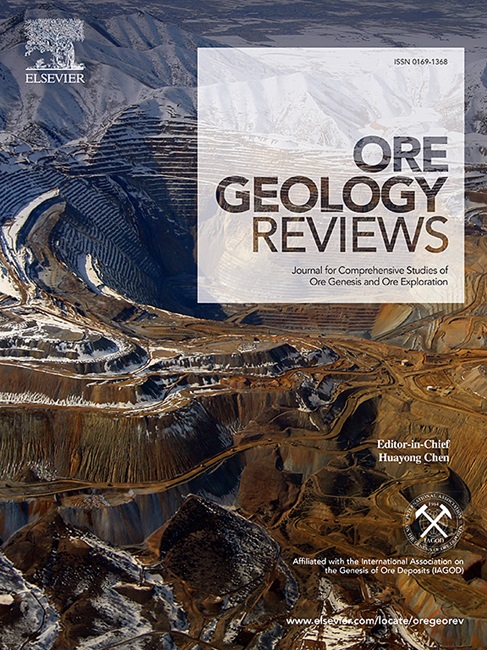高度演化花岗岩中的铷富集过程:从东天山白石头泉岩体的云母和钾长石中获得的启示
IF 3.2
2区 地球科学
Q1 GEOLOGY
引用次数: 0
摘要
高度演化的花岗岩与稀有金属矿化密切相关。然而,稀有金属富集的控制机制仍未得到很好的解释。张宝山铷矿床所在的东天山高度演化白石头泉(BST)岩体已经得到了很好的描述,为研究花岗岩体系中的铷富集过程提供了绝佳的机会。BST 长岩有五个岩性带,从下到上依次为白云母岩(a 区)、含亚砂岩花岗岩(b 区)、亚砂岩花岗岩(c 区)、含黄玉亚砂岩花岗岩(d 区)和黄玉白云母花岗岩(e 区)。为了研究 BST 长岩中的 Rb 富集过程,对不同岩性区中富含 K(-Rb)矿物的成分变化进行了描述,并结合纹理变化进行了解释。该岩浆岩中主要的含钾和含铷矿物是云母和钾长石,分别以辉绿岩和微绿泥石为主。e区的辉长岩呈边界不规则的八面体晶粒,表明它们是从白石头泉岩浆中结晶出来的,并受到热液的覆盖。辉绿岩一般富含 F(1.05-9.94 wt%)、Li(780-10171 ppm)和 Rb(3133-6657 ppm),并具有 K/Rb 和 Nb/Ta 比率低的特点。大多数微细长岩晶粒呈拉长的正八面体-次正八面体板条状,具有格子状和卡尔斯巴德孪晶。这些微晶石晶粒富含铷(1547-2927 ppm)、铅(15-120 ppm)和铯(14-100 ppm),钾/铷和钙/镓比率较低。在BST岩体中,辉绿岩中的锂、萤石和铷的浓度从a区到c区逐渐升高,然后在d区和e区逐渐降低。相反,K/Rb和Nb/Ta比率从a区到c区下降,然后在d区和e区上升。微晶岩的铷浓度和钾/铷比值也呈现类似的趋势。考虑到各区岩性的逐渐变化,从a区到c区的矿物化学变化意味着岩浆以晶体分馏为主的持续演化。在d区和e区,次生云母的出现以及辉石和微云母的地球化学突变表明了热液活动。从d区到e区,微云母的Al/Ga比值逐渐降低,并且出现了成分与原生云母相似的次生云母,这表明流体起源于岩浆。在岩浆演化过程中,富挥发性(如 F)熔体的粘度和凝固温度低于贫挥发性熔体,使其能够经历极端程度的分馏结晶。这大大提高了铷的溶解度,导致残余熔体中的铷不断富集。随着 BST 系统从岩浆过程为主演变为热液活动为主,黄玉的结晶消耗了 F,降低了 Rb 在熔体中的溶解度,导致辉绿岩和微绿泥石中的 Rb 浓度下降。辉绿岩的热液蚀变会将铷释放到流体中,导致次生云母中的铷浓度低于原生云母。因此,BST岩浆中Rb的富集主要受控于富含F的花岗岩岩浆的极度分馏结晶。本文章由计算机程序翻译,如有差异,请以英文原文为准。

Rb enrichment processes in highly evolved granites: Insights from mica and K-feldspar from the Baishitouquan pluton, Eastern Tianshan
Highly evolved granites are closely related to rare metal mineralization. The mechanisms controlling rare metal enrichment, however, remain poorly constrained. The highly evolved Baishitouquan (BST) pluton in the Eastern Tianshan, which hosts the Zhangbaoshan Rb deposit, has been well characterized and provides an excellent opportunity to study Rb enrichment processes in granitic systems. The BST pluton has five lithological zones, which, from bottom to top, are leucogranite (Zone-a), amazonite-bearing granite (Zone-b), amazonite granite (Zone-c), topaz-bearing amazonite granite (Zone-d), and topaz albite granite (Zone-e). To investigate Rb enrichment processes in the BST pluton, compositional variations in K(–Rb)-rich minerals from the different lithological zones are characterized and interpreted in the context of textural variations. The main K- and Rb-bearing minerals in the pluton are mica and K-feldspar, which are mainly represented by phengite and microcline, respectively. Phengite in Zone-e occurs as euhedral grains with irregular boundaries, indicating that they crystalized from the Baishitouquan magma and were overprinted by hydrothermal fluids. Phengite is generally enriched in F (1.05–9.94 wt%), Li (780–10171 ppm), and Rb (3133–6657 ppm), and is characterized by low K/Rb and Nb/Ta ratios. Most microcline grains occur as elongate, euhedral–subhedral laths, with tartan and Carlsbad twinning. These microcline grains are enriched in Rb (1547–2927 ppm), Pb (15–120 ppm), and Cs (14–100 ppm), and have low K/Rb and Al/Ga ratios. In the BST pluton, the concentrations of Li, F, and Rb in phengite increase from Zone-a to Zone-c, then decrease in Zone-d and Zone-e. Conversely, the K/Rb and Nb/Ta ratios decrease from Zone-a to Zone-c, then increase in Zone-d and Zone-e. The Rb concentration and K/Rb ratio of microcline exhibit a similar trend. Considering the gradual changes in lithology among the zones, the variations of mineral chemical from Zone-a to Zone-c implies continuous evolution of the magma dominated by crystal fractionation. The occurrence of secondary mica, and the abrupt geochemical changes in phengite and microcline in Zone-d and Zone-e are indicative of hydrothermal activity. The gradual decrease in Al/Ga ratio of microcline from Zone-d to Zone-e and the presence of secondary mica that is compositionally similar to primary mica suggests that the fluids were magmatic in origin. During magmatic evolution, volatile-rich (e.g., F) melts have lower viscosities and solidus temperatures than volatile-poor melts, allowing them to undergo extreme degrees of fractional crystallization. This significantly enhances the solubility of Rb, leading to continuous enrichment of Rb in the residual melt. As the BST system evolved from one dominated by magmatic processes to one dominated by hydrothermal activity, the crystallization of topaz consumed F, reducing the solubility of Rb in the melt, and leading to a decrease in the concentration of Rb in phengite and microcline. Hydrothermal alteration of phengite would have liberated Rb into the fluids, resulting in lower Rb concentrations in secondary mica compared to primary mica. Therefore, the enrichment of Rb in the BST pluton was mainly controlled by extreme degrees of fractional crystallization of a F-rich granitic magma.
求助全文
通过发布文献求助,成功后即可免费获取论文全文。
去求助
来源期刊

Ore Geology Reviews
地学-地质学
CiteScore
6.50
自引率
27.30%
发文量
546
审稿时长
22.9 weeks
期刊介绍:
Ore Geology Reviews aims to familiarize all earth scientists with recent advances in a number of interconnected disciplines related to the study of, and search for, ore deposits. The reviews range from brief to longer contributions, but the journal preferentially publishes manuscripts that fill the niche between the commonly shorter journal articles and the comprehensive book coverages, and thus has a special appeal to many authors and readers.
 求助内容:
求助内容: 应助结果提醒方式:
应助结果提醒方式:


